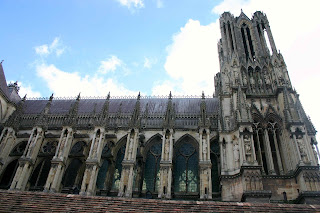Russia is not usually considered part of medieval Europe, but its history is closely tied to the countries to the west. For that matter, it's difficult to draw lines between western Europe, eastern Europe, central Asia, and east Asia, given that they are all on a big contiguous land mass with no sharp dividing lines (south Asia, that is India and Pakistan and Bangladesh, at least has the Himalayas for demarcation).
Everything happened later in Russia, if one takes medieval France as the model to which all must conform (medieval French monks and knights would certainly have so argued, as do a number of modern scholars in France), from organized government to organized religion. Its ethnic and cultural history is very complicated, because the wide grasslands and steppes provide no barriers to various people coming to settle or to conquer.
Russia first appears in written history in the ninth century, when its first organized government was established by the so-called Rus Vikings. Bet you didn't know Vikings were so far inland. But they had established trade routes stretching from the Baltic Sea all the way across central Asia to fetch up in Constantinople, where a number of Norsemen signed on as soldiers, the so-called Varangian guard. Some of them however decided to settle down halfway there and carve out their own kingdom, with Kyiv established as the capital.
So although the Russian version of the story is that Ukraine is part of Russia, historically speaking Russia is part of Ukraine.
The Vikings mingled with the native Slavic peoples in a kingdom bigger than anything further west. It included (very roughly) the same territory as modern Ukraine, Belarus, and the more western parts of Russia. They adopted Christianity late in the tenth century, getting it from Constantinople, but Russian Orthodoxy (as it is now known) had a number of differences from Greek Orthodoxy, starting with using Old Church Slavonic as the main language of religion rather than Greek.
The first ruler of Kyiv to convert was named Volodymyr, and this name (or its Russian version, Vladimir) continues to be a popular name in the region today. Volodymyr's son Yaroslav's children were the first generation to be brought up Christian from birth, and they quickly began marrying the royal families of western Europe. Western kings had almost exhausted the supply of royal princesses to whom they were not already closely related, and the conversion of the rulers of Kyiv provided many brides. Anna, the queen of King Henry I of France (d. 1060), for example, was one of Yaroslav's daughters.But in the thirteenth century this flourishing principality was conquered by the Mongols, the Golden Horde (think Genghis Khan). They continued under Mongol rule for the next two hundred years. During this time the dukes of Moscow were able to establish themselves, in part by being little friends of the Mongols, but in the fifteenth century they led the war that ended Mongol rule. Since then, Russian territory has had Moscow as its capital.
The history of the whole region becomes even more complicated in the early modern period. Just for example, Lithuania, now a tiny Baltic republic, was part of the great Polish-Lithuanian empire in the seventeenth century. Then, in the eighteenth century, Poland (and Lithuania) were divided up three-ways between Russia, Germany, and the Austro-Hungarian empire. (Later they came back.)
But both Ukraine and Russia began in this period to consider themselves true nations, with their own language and culture (Ukrainian is similar to Russian though not the same). Russia had the advantage of having its own emperors, the tsars, throughout this period, starting in the sixteenth century. (The word tsar, of course, comes from Caesar, indicating their conception of themselves as continuing the traditions of ancient Rome and ancient Byzantium.)
Ukraine was not so successful, as they were usually controlled either by Russia or by Poland. The name Ukraine means "border land," the land between the Baltic and the Russians of Moscow. (The country wants to be known as Ukraine, rather than the Ukraine, because they fear the latter would suggest they were just an outlying border region of Russia.) When Russia went Communist in 1917, Ukraine tried to assert independence but were dragged back into the fold. They have only been a recognized separate country since 1991, when they became their own republic during the breakup of the old Soviet Union.
And I haven't even talked about how Russia didn't really get serfs until the early modern period, when serfdom was long gone in western Europe. "Medieval" Russia, unlike western Europe, is assumed to persist until the eighteenth century or so, rather than stopping in 1500. The history of the region continues today to be the basis of sweeping arguments about what the region ought to be like today.
© C. Dale Brittain 2022
For more on medieval nations, see my new ebook, Positively Medieval: Life and Society in the Middle Ages. Also available in paperback.





